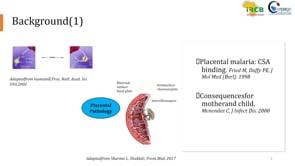ASTMH 2019, Tatiana Sandrine Hountohotegbe: “Memory B and functional anti body responses to the PAMVAC vaccine candidate during Phase Ib clinical trial in Benin”
Collaborator(s): Research Centre on Malaria Associated with Pregnancy and Childhood (CERPAGE), Benin
Published: 23/11/2019
In collaboration with ASTMH, Image Audiovisuals, and session presenters, MESA brings you this webcast from the 68th ASTMH annual meeting in Maryland, November 2019.
Title: “Memory B and functional anti body responses to the PAMVAC vaccine candidate during Phase Ib clinical trial in Benin”
Speaker: Tatiana Sandrine Hountohotegbe, Centre d’Etude et de Recherche sur le Paludisme Associé à la Grossesse et à l’enfance (CERPAGE), UMR261, Cotonou, Benin
Session information:
November 23, 2019, 10:15 AM – 12:00 PM, Maryland B (Ballroom Level)
Abstract:
Placental Malaria (PM) pathogenesis is caused by interactions between the parasite protein VAR2CSA and chondroitin sulfate A (CSA) in the human placenta. The PAMVAC vaccine is a VAR2CSA protein-based vaccine, aiming to protect fetus and mother against the adverse effects of PM. After a safe Phase Ib clinical trial conducted in Benin from November 2016 to September 2017, PAMVAC immunogenicity was explored in 21 healthy nulligravid adult females randomized in 3 groups (9 Alhydrogel, 9 GLA-SE, 3 Placebo). They received 3 doses of 50 µg of adjuvanted PAMVAC or Placebo 28 days apart (Day 0, 28 and 56). Plasma samples and PBMC harvested at Days (D) -1, 56, 84, 168, 252 were stored respectively at -20°C and in liquid nitrogen for immunoassays. Memory B cells were quantified by ELISpot and functional antibody properties assessed for Variant Surface Antigen (VSA) recognition and opsonic phagocytosis using FACS. PAMVAC vaccination induced a memory B response that increased noticeably after the 2nd dose of vaccine (D56) and persisted over time at levels substantially higher than those we have previously measured in multigravid Beninese. The frequency of PAMVAC-specific antibody-secreting B cells was notably higher with GLA-SE than with alum, and responses were stable between D56 and D84. PAMVAC-specific B cell responses were undetectable in the Placebo group. PAMVAC immunization also induced antibody-mediated homologous VSA recognition and opsonic phagocytosis activities. IgG1 and IgG3 responses to VSA were higher in both adjuvant groups compared with Placebo, and opsonic phagocytosis of infected red blood cells was observable from D56 in the vaccinated groups. PAMVAC with alum induced stronger opsonic phagocytosis than with GLA-SE. In conclusion, the combination of PAMVAC with GLA-SE rather than alum was associated with the strongest B cell responses, whilst the combination with alum was associated with stronger functional antibody responses in women of childbearing age before their first pregnancy.
THEMES: Vaccines



